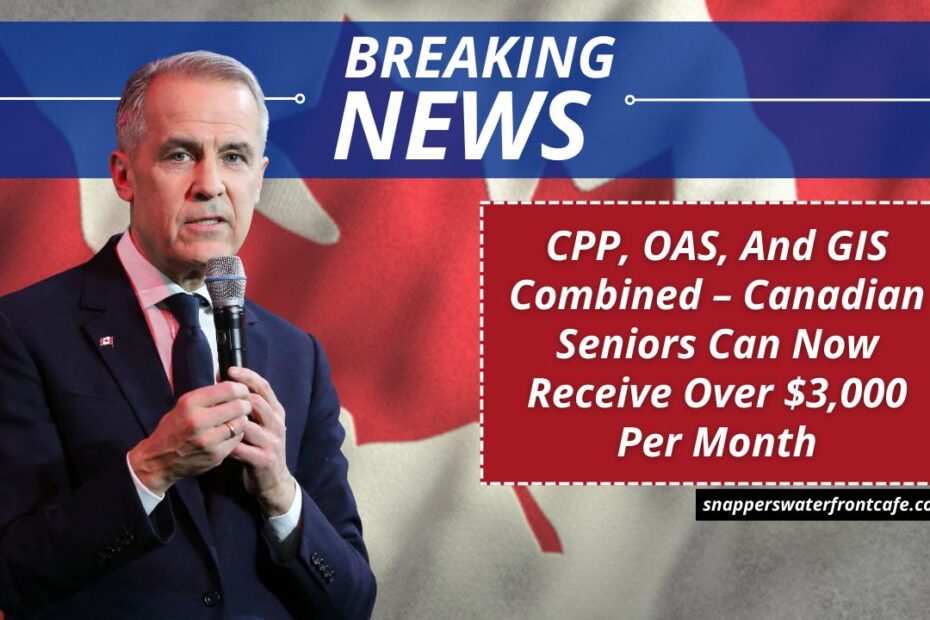Many Canadian seniors are still unaware that they can now earn up to $3,000 per month in retirement income by combining the Canada Pension Plan (CPP), Old Age Security (OAS), and the Guaranteed Income Supplement (GIS).
These three programs together form a powerful support system, ensuring retirees—especially those with limited personal savings—can maintain financial stability in today’s climate of rising inflation and higher living costs.
This combined structure represents one of the biggest pension improvements in recent years, providing a much-needed safety net for seniors across Canada.
Understanding CPP, OAS, and GIS Together
The Canadian government has designed three distinct yet interconnected programs—CPP, OAS, and GIS—to provide seniors with layered financial support.
- Canada Pension Plan (CPP): Based on contributions made during your working years.
- Old Age Security (OAS): A universal benefit for Canadians over 65, based on residency.
- Guaranteed Income Supplement (GIS): A non-taxable benefit for low-income seniors who qualify for OAS.
Individually, each program has its eligibility rules and limitations. But when combined strategically, they create a reliable income system that can reach over $3,000 monthly for eligible seniors.
How Each Program Works
Canada Pension Plan (CPP)
The CPP provides monthly retirement payments that begin as early as age 60. The amount depends on:
- Contributions during your working years (both employee and employer contributions).
- Age when you start collecting CPP (payments are higher if you delay past 65).
- Number of years contributed to the plan.
The maximum CPP payout at age 65 in 2025 is CAD $1,364.60 per month for individuals who contributed the maximum amount during their career. Since CPP counts as taxable income, it also affects GIS eligibility.
Old Age Security (OAS)
The OAS is available to Canadians aged 65 or older and is based on residency rather than work history.
- To receive the full OAS pension, individuals generally need 40 years of Canadian residency after the age of 18.
- A partial OAS is paid if the residency requirement is lower.
- In 2025, the maximum OAS monthly payment is CAD $748.
Receiving OAS is a prerequisite for qualifying for GIS.
Guaranteed Income Supplement (GIS)
The GIS is a non-taxable benefit that provides additional financial support for low-income seniors already receiving OAS.
- The maximum monthly GIS payment for a single senior is CAD $1,065.47 in 2025.
- Eligibility is influenced by annual net income (ANI) and marital status.
- Unlike CPP, OAS itself does not reduce GIS, though other income sources (like pensions or RRSP withdrawals) can.
For low-income retirees, the GIS provides the largest boost, significantly raising the total monthly support.
Maximum Monthly Payment Breakdown
Here’s how much eligible seniors can receive if they qualify for maximum CPP, full OAS, and GIS in 2025:
| Program | Maximum Monthly Amount | Eligibility Requirements |
|---|---|---|
| CPP | CAD $1,364.60 | Full contributions over career; claimed at age 65 |
| OAS | CAD $748 | Age 65+, with 40+ years of residency |
| GIS (Single) | CAD $1,065.47 | Low-income seniors receiving OAS |
| Total | $3,178.07 per month | For seniors qualifying for maximum benefits in all three programs |
How to Maximize Your Combined Benefits
Getting the maximum $3,000+ monthly benefit requires smart planning. Factors that can influence your payout include:
- When you apply: Delaying CPP or OAS can increase monthly payments.
- Managing other income sources: Drawing too much from RRSPs or pensions may reduce your GIS eligibility.
- Accurate tax filing: Properly reporting income ensures you don’t miss out on benefits.
- Strategic retirement planning: Working with a financial expert can help you determine the best timing and combination.
For many seniors, carefully balancing these choices can mean the difference between financial strain and comfort in retirement.
Key Considerations for Seniors
- Consult a financial advisor: Professional advice can help optimize benefits.
- Stay updated: Government rules, payment dates, and eligibility criteria change periodically.
- Understand taxation: Both CPP and OAS are taxable, while GIS is not. Proper tax planning ensures you retain maximum income.
Why This Matters for Canadian Seniors
For many retirees without workplace pensions or large personal savings, CPP, OAS, and GIS act as a financial lifeline. Together, these benefits provide:
- Reliable monthly income during retirement.
- Protection against inflation and rising costs of living.
- A stable financial base to help seniors live independently and securely.
This combined system ensures that even seniors with limited savings can maintain a decent standard of living.
The Canadian retirement system, through CPP, OAS, and GIS, offers seniors a way to secure more than $3,000 per month if they qualify for maximum benefits.
Understanding how these programs work together is essential for financial stability during retirement.
With proper planning—such as delaying CPP, managing taxable income, and staying informed about changes—retirees can maximize their benefits and build a more comfortable future.
Frequently Asked Questions
Can I receive CPP, OAS, and GIS at the same time?
Yes. As long as you meet the income and contribution requirements, you can collect all three benefits simultaneously.
Does working after retirement affect my GIS?
Yes. Even a small income from work can reduce the GIS amount since it’s calculated based on annual net income.
What happens if my income rises during the year?
Your GIS eligibility and amount are reviewed annually, based on the previous year’s income. If your income increases, your GIS payment may be reduced in the following year.



